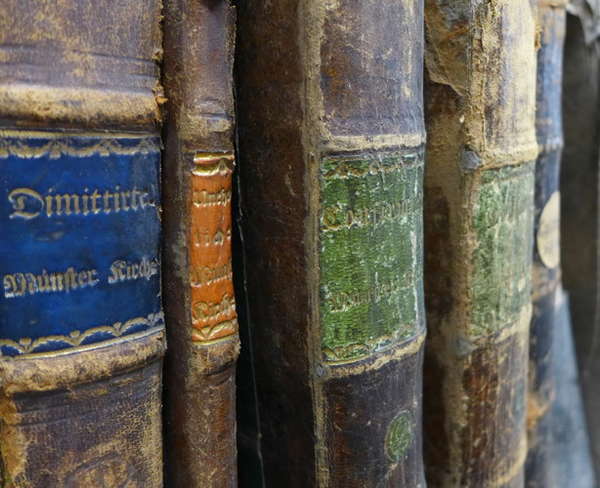Sources for genealogy: Church books
- 24. January 2021 - Genealogy, General, Germany, Historical Documents, Knowledge, Tips and Tricks
We did not forget our top 10 sources for genealogy. How could we? After all, we are working with them on a daily basis. Today we would like to share some information on church books in Germany.
Relevance
Without church books, genealogical research in Germany would be barely possible. At least you would not be able to go back very far. Prior to the implementation of civil registry offices in 1874/1876 and with them of birth-, marriage and death certificates, church books are the main source for genealogy in Germany. And even for the times in which civil registry documents existed, church documentation can provide further information or can be used as an alternative, if the civil documents are lost.
Usually, there are chronological books for baptism, marriages and burials. Additionally, there might be lists of candidates for confirmation, communicants (attendees of the Eucharist/Holy Communion) or even family registers (compiling whole families with all children, mainly in today’s Baden-Wuerttemberg). Sometimes, there are also lists of church members preserved.
Unfortunately, the information is not always as accurate as one would hope. In this respect, church books are as prone to error as other old sources. Often, it was only possible to record what was actually known or what one thought to know.
In contrast to civil registry documents, it was usually more important to record the religious actions rather than the biographical data of a person. This means, it was recorded that a person was baptized or buried rather than that he or she was born or died. Still, often and especially in newer church books the actual birth and death dates are mentioned, too. It is however possible that only one date was recorded - in these cases it is usually the church date.
The information given in the entries can vary greatly. Especially older entries often only contain the basic information, meaning the names of the directly involved persons and the date of the sacrament (the official church act). Sometimes even the name of the mother is missing in a baptism. However, there can also be exciting additional information: baptism entries might for example contain information on professions, places of residence and marriage date of the parents, marriage entries might give the names of the parents, the age, place of residence and marital status of the couple and maybe even information on prior partners, the dates for the wedding banns etc. Burial entries can contain for example information on the cause of death and with a little luck even quite extensive information on the surviving parties, meaning parents, spouses and children - sometimes there is even information on their fate and their descendants.
Information on godparents and witnesses can also be very interesting for genealogy. They were often family members and given places of residence can provide new hints for the research and sometimes help to overcome brick-walls.
Storage and access
Church books can be stored in many different places in Germany. In order to find an entry, it is important to know the religion of a person, since often, Lutheran and Catholic church books are not stored at the same place, but at the respective churches or in their archives.
Where the documents are stored, highly depends on the actual place of residence of the sought person. It is important to know which parish was responsible (this might have changed over the years). For the years from 1874/1876 onwards, usually the respective parish office is the first point of contact. As with the civil registry documents there are periods of protection that can restrain the research, they may vary from church to church.
Older church books can sometimes still be stored at the parish office, too. More often, they are, however, handed over to (egional) church, city, district or state archives. Sometimes, secular archives have copies on microfilm.
If you are looking for documents from the former eastern provinces of Germany, it gets even more complicated. These documents might, if they are preserved at all, for example be in the country the place belongs to today, at the Evangelical Central Archives in Berlin or on Catholic side for example at the Episcopal Central Archive Regensburg. They might also be at a responsible diocesan archive, other church organizations or even at secular archives.
Lutheran as well as Catholic church books are sometimes already digitalized and can be viewed online. The most important places to look are for German Lutheran church books the fee-based online portal Archion and for Catholic church books the online portal Matricula which can be used free of charge.
For religions that were minorities, sometimes entries can be found within the church books of the predominant religions (sometimes they even had special books just for the minority religions). Sometimes, the entries can only be found in the copies of the church books. It is also possible that there were books at secular administrative offices. Depending on the time and place it is of course also possible that there were own books of the religious communities or their followers had to go to the nearest church of their own religion.
Reading church books can often be quite demanding. As always, the handwriting and different spellings of surnames can be a problem. To the last names of women, often an -in was added or they were changed in other ways. Catholic church books were written in Latin for quite a long time. This did not only concern the text itself, but even the names were changed accordingly. A Jacobus was for example probably rather a Jacob in normal life. In some regions it is also possible to come across French in church books (if they were Huguenots or under French occupation for instance). Information on dates can also be tricky, e.g., if the church calendar was used. Also, do not be surprised, if some information seems strange, for example regarding documents that had to be presented.
When looking for entries, one should also try to think outside the box and not give up too soon. Especially if something was not in compliance with the position of the church, clergymen were often anxious to make this obvious. Unkind names for illegitimate children or even their banishment to the end of the church book or entries written upside down are only possible examples.
Often, a baptism did not take place directly on the day of the birth. How much time passed, could depend on various factors. The religion is one of them. Catholic families usually baptized their children soon after the birth, Lutheran families often waited longer - sometimes up to 4 or 5 years. Due to the high infant mortality and the fees that had to be paid for a baptism, parents sometimes waited in order to see, if the child lived and maybe several siblings were baptized at the same time in order to save costs.
History
There were church books in Germany as early as in the 15th century or even earlier - however, not of all churches. The earliest preserved church books are from the 16th century. The years in which the first books exist in parishes vary greatly and are to be checked for each individual case. Often, the records start only after the Thirty Years’ War (1618-1648), since during this time many books were destroyed. Other wars, especially World War II, were also disastrous for some church book holdings. Especially a family research in the former eastern provinces of Germany can be rather frustrating, since many holdings were lost or destroyed (civil registry documents as well as church documents).
In the beginning, the books were usually written in continuous text. This makes reading and especially skimming through them much harder. Later, often tabular forms were introduced that improved the legibility greatly.
From around the 18th century onwards, copies of church books were made. If both versions are actually preserved, they both can be relevant for genealogy. Copies are naturally a little more prone to error than the originals (since there might have been mistakes in the process of copying) and also often contain less information. However, it is also possible that they actually do contain additional information that was not recorded in the original. The copies were at least in part used as a federal source (as a basis for lists for military service, tax or census for example). They were also made as a precaution in case the original was destroyed.
Even after the civil registry offices and with them the official civil documents were introduced in 1874/1876, church books were continued - until today. They are, however, not the official federal source anymore, which means that church archives are not legally bound to hand out information for the time after 1874/1876.


01. February 2021
Thank you very much for sharing your experiences. In general, thinking outside the box can very much help with the research in church book entries (and other sources) when the information you are looking for seems to be missing at first glance. It is sometimes surprising how much information other entries can contain.
31. January 2021
When researching in marriage records, it can be frustrating when the names of the parents of the bride and groom are not given. Sometimes you can solve this by looking at all of the baptisms for a few years before the marriage. When a young person served as a godparent, the record often gives the name of his/her father, which is later omitted when that godparent is married.
In many churches, when a widow or widower married, the names of the parents of the bride and groom were not given, and sometimes it does not even say that they were widowed. Check for the possibility of an earlier marriage, which may have the parents' names that were omitted in later marriages.